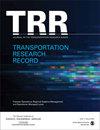Terra Incognita: California Transit Agency Perspectives on Demand, Service, and Finance in the Age of COVID-19
IF 1.8
4区 工程技术
Q3 ENGINEERING, CIVIL
引用次数: 0
Abstract
The COVID-19 pandemic upended transit use, finance, and management. To investigate these effects two years into the pandemic, we conducted 21 semi-structured interviews with senior managers at transit agencies in the most populous U.S. state, California. We found that the pandemic generated many operational and managerial challenges for transit agencies. Ridership plummeted, then slowly recovered, but is still well below pre-pandemic levels at most agencies. Commuter trips to and from major job centers were especially slow to return. In response to decreased demand, public health concerns, and uncertain finances, many agencies cut services and spending early on. As a result, fare revenues declined, in some cases precipitously. However, federal pandemic relief funds proved essential in filling budgetary gaps, stabilizing finances, preventing layoffs, and maintaining services. Other transit subsidies mostly bounced back robustly. Our interviews suggest that, though California transit agencies experimented with free fares, few fareless programs were made permanent. Their challenges include considerable uncertainty associated with future travel demand, looming financial shortfalls at systems that formerly had high farebox recovery and are still drawing on federal pandemic funds to backfill their fare revenue losses, and protracted labor shortages of drivers and mechanics that are preventing many systems from providing desired levels of service.未知领域:加州交通机构在COVID-19时代对需求、服务和财务的看法
2019冠状病毒病大流行颠覆了交通运输的使用、融资和管理。为了调查大流行两年后的这些影响,我们对美国人口最多的加利福尼亚州的运输机构的高级管理人员进行了21次半结构化访谈。我们发现,大流行病给过境机构带来了许多业务和管理方面的挑战。客流量急剧下降,然后缓慢恢复,但在大多数机构仍远低于大流行前的水平。往返于主要就业中心的通勤出行尤其缓慢。为了应对需求下降、公共卫生问题和不确定的财政状况,许多机构早早削减了服务和支出。结果,票价收入下降,在某些情况下甚至是急剧下降。然而,事实证明,联邦大流行病救济基金在填补预算缺口、稳定财政、防止裁员和维持服务方面至关重要。其他交通补贴大多强劲反弹。我们的采访表明,尽管加州的公交机构尝试过免费乘车,但很少有免费乘车的项目被永久保留下来。他们面临的挑战包括:与未来出行需求相关的相当大的不确定性;以前票价回收率高、仍在利用联邦流行病基金弥补票价收入损失的系统即将出现资金短缺;以及司机和机械师的长期劳动力短缺,这阻碍了许多系统提供预期的服务水平。
本文章由计算机程序翻译,如有差异,请以英文原文为准。
求助全文
约1分钟内获得全文
求助全文
来源期刊

Transportation Research Record
工程技术-工程:土木
CiteScore
3.20
自引率
11.80%
发文量
918
审稿时长
4.2 months
期刊介绍:
Transportation Research Record: Journal of the Transportation Research Board is one of the most cited and prolific transportation journals in the world, offering unparalleled depth and breadth in the coverage of transportation-related topics. The TRR publishes approximately 70 issues annually of outstanding, peer-reviewed papers presenting research findings in policy, planning, administration, economics and financing, operations, construction, design, maintenance, safety, and more, for all modes of transportation. This site provides electronic access to a full compilation of papers since the 1996 series.
 求助内容:
求助内容: 应助结果提醒方式:
应助结果提醒方式:


